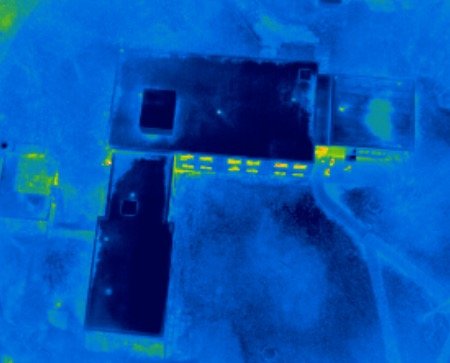What do you mean it’s too warm?
Each year we generally get one or two heat loss survey requests in May. In fact, it’s become something of a tradition. The answer is always one which the client doesn’t want: come back in November. So, why is this?
The fundamental reason is that heat loss surveying relies squarely on a temperature difference across the envelope of the building interior/exterior. Without this delta, there isn’t really anything to measure.
But temperature isn’t the only environmental requirement for good building thermography. Here’s a look at what we need, and why.
Temperature
The temperature difference between interior and exterior is critical, and we specify an absolute minimum difference of 10C. 15C is preferable. And it’s not just the difference itself, but also how long that difference has been present. What we are trying to do is to load the building with as much thermal energy as possible, and then see how much of it leaks to the outside. And, by doing that over an extended period, we are minimising the variations in temperature seen while a building warms up (for example, a wall above a radiator will heat up much more quickly than the adjacent wall).

Legacy building surveyed on a cold night, with evident heat loss between the panels of wooden cladding
Wind
Calm conditions are also important for good results, especially when the temperature difference between inside and out is modest. This is because we want to minimise the effects of wind chill.
With a strong wind, measurable higher temperatures on the exterior of the building will be negated by wind chill. Also, apparent differences in performance between sheltered and unsheltered walls may present themselves when in fact they are illusory.
That said, a lack of wind chill also means that lingering effects of warmer daytime temperatures need to be factored in. For example, a corner between two elevations at right angles will appear warmer than the surrounding areas, even though there is no significant difference in construction performance.
Rain v Sun
Here’s where things can get very frustrating. Ideally, we need dry conditions before and during the survey, but also no direct sunlight. Getting both of those can be something of a waiting game.
Wet surfaces cause significant problems because they do not change temperature at the same rate as neighbouring dry surfaces. On the roof below there are two areas where water tends to pool. As the survey has been done too soon after nightfall, they are showing slightly warmer than the surrounding area. This is not, however, an indication of heat loss in those areas.

Likewise, any direct sunlight on the surfaces either during or immediately before the survey will cause problems. This is because the source of the thermal energy cannot be separated from other causes (e.g. lost from the inside of the building). And this solar gain can linger for a remarkably long time, even 6 hours or so into the early evening.
And as if that were not enough… Humidity
The thermal surveyor’s life is nothing if not a waiting game. Whilst an overcast day is desirable for avoiding solar gain, clouds generally bring humidity which is in itself a big problem for thermography.
In the IR wavelength which a thermal imager is detecting, high humidity creates a barrier between the sensor and the subject. It’s analogous to mist and fog in the visible spectrum. The result is an image which appears both ‘fuzzy’ and prone to show ‘false’ lower temperatures. For this reason, high humidity is to be avoided.

High relative humidity causing loss of IR detail and accuracy
And so, be patient….
As you’ll now appreciate, building thermography is not a game for the impatient surveyor. And we request your patience too – sometimes the best things really do come to those who wait.
Sapiens undertakes commercial heat loss surveys, including for BREEAM accreditation. Contact us today for more information and pricing.

